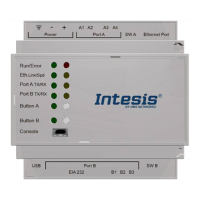
Do you have a question about the HMS Networks Intesis IN700-485 Series and is the answer not in the manual?
| Brand | HMS Networks |
|---|---|
| Model | Intesis IN700-485 Series |
| Category | Gateway |
| Language | English |
Describes the manual's purpose and scope for installation, configuration, and operation of the Intesis gateway.
Provides critical safety instructions for installation and operation to prevent harm and equipment damage.
Explains DANGER, WARNING, and CAUTION messages and symbols used to indicate hazardous situations.
Defines key terms used in the manual for clarity, such as gateway, application, and control system.
Outlines the gateway's capability to integrate Serial and IP protocols, listing supported applications.
Details the quick and easy steps involved in configuring the Intesis gateway using the software tool.
Describes integrating Modbus RTU/TCP into BACnet IP/MSTP systems, enabling access to signals.
Explains how Modbus registers are mapped to BACnet objects for seamless system perception.
Details integrating BACnet MSTP/IP into Modbus RTU/TCP systems, allowing Modbus to access BACnet resources.
Describes how BACnet objects are associated with Modbus registers for Modbus system perception.
Explains integrating BACnet/IP and MSTP devices into ASCII IP or Serial systems for data access.
Covers how BACnet objects are mapped to ASCII objects, allowing ASCII systems to perceive BACnet installations.
Introduces BACnet concepts, defining client and server roles, and device objects/properties.
Discusses the gateway acting as a BACnet client, classified as a BACnet Application Specific Controller (B-ASC).
Details the gateway's BACnet Device Object, including its Identifier and basic gateway properties.
Details BACnet features associated with each point, including device, object type, and instance.
Covers the gateway acting as a BACnet server, classified as BACnet Advanced Application Controller (B-AAC).
Describes the gateway's role as a BACnet server and configuration of object types for signals.
Explains BACnet IP configuration, including UDP port, IP settings, and foreign device/BBMD functionality.
Details BACnet MSTP configuration, including MAC address, supported baud rates, and wiring.
Introduces Modbus as a master-slave protocol for device communication, supported modes TCP and RTU.
Explains the gateway acting as a Modbus server via Ethernet (TCP) or serial ports (RTU).
Details the gateway's role as a Modbus server supporting both TCP and RTU modes simultaneously.
Lists the Modbus functions supported by the gateway for reading and writing data.
Covers Modbus RTU configuration parameters like baud rate, parity, stop bits, and physical connection.
Details Modbus TCP configuration, including IP settings, TCP port, and its benefits for communication.
Explains Modbus register configuration, including bits, data coding, byte order, and register address.
Describes the gateway acting as a Modbus client for TCP/RTU networks, connecting to server devices.
Details the gateway's client role, supporting multiple Modbus TCP servers and serial RTU integration.
Lists Modbus features for points, including device, function code, #Bits, data coding, byte order, and register address.
Explains connecting to ASCII devices via serial or TCP/IP for supervision and control using simple messages.
States that ASCII serial interface and master device connection type must match.
Details ASCII TCP configuration parameters: TCP port, IP address, subnet mask, and default router.
Notes that the ASCII address map is fully configurable for any point in the gateway.
Defines ASCII features for points: signal, ASCII string, read/write, spontaneous messages, and A/D type.
Explains the format of ASCII messages for reading and writing point values, including spontaneous messages.
Details power supply requirements, including voltage range, connector types, and safety precautions.
Provides visual diagrams illustrating connection setups for various gateway applications.
Explains how to connect the gateway to Modbus networks via Ethernet (TCP) or serial ports (RTU/EIA-485/EIA-232).
Details connections for BACnet IP (Ethernet) and BACnet MSTP (EIA-485) to the gateway.
Describes how to connect to ASCII devices via Ethernet (TCP) or serial ports (EIA-485/EIA-232).
Explains connecting the gateway via console port (USB) for configuration and using the USB port for storage.
Lists necessary items and software for gateway integration, including the gateway, cables, and configuration tool.
Introduces Intesis MAPS, the Windows software for monitoring and configuring Intesis gateways.
Guides on selecting the appropriate template within Intesis MAPS for the desired application.
Explains how to establish a connection with the gateway using either IP or USB port in Intesis MAPS.
Details configuring general parameters and protocol-specific settings within the Intesis MAPS Configuration tab.
Describes the Signals tab in Intesis MAPS for listing and configuring available signals and parameters.
Explains how to send configuration to the gateway and receive its current configuration using Intesis MAPS.
Covers using the Diagnostic tab in Intesis MAPS to check gateway status, save logs, and get information.